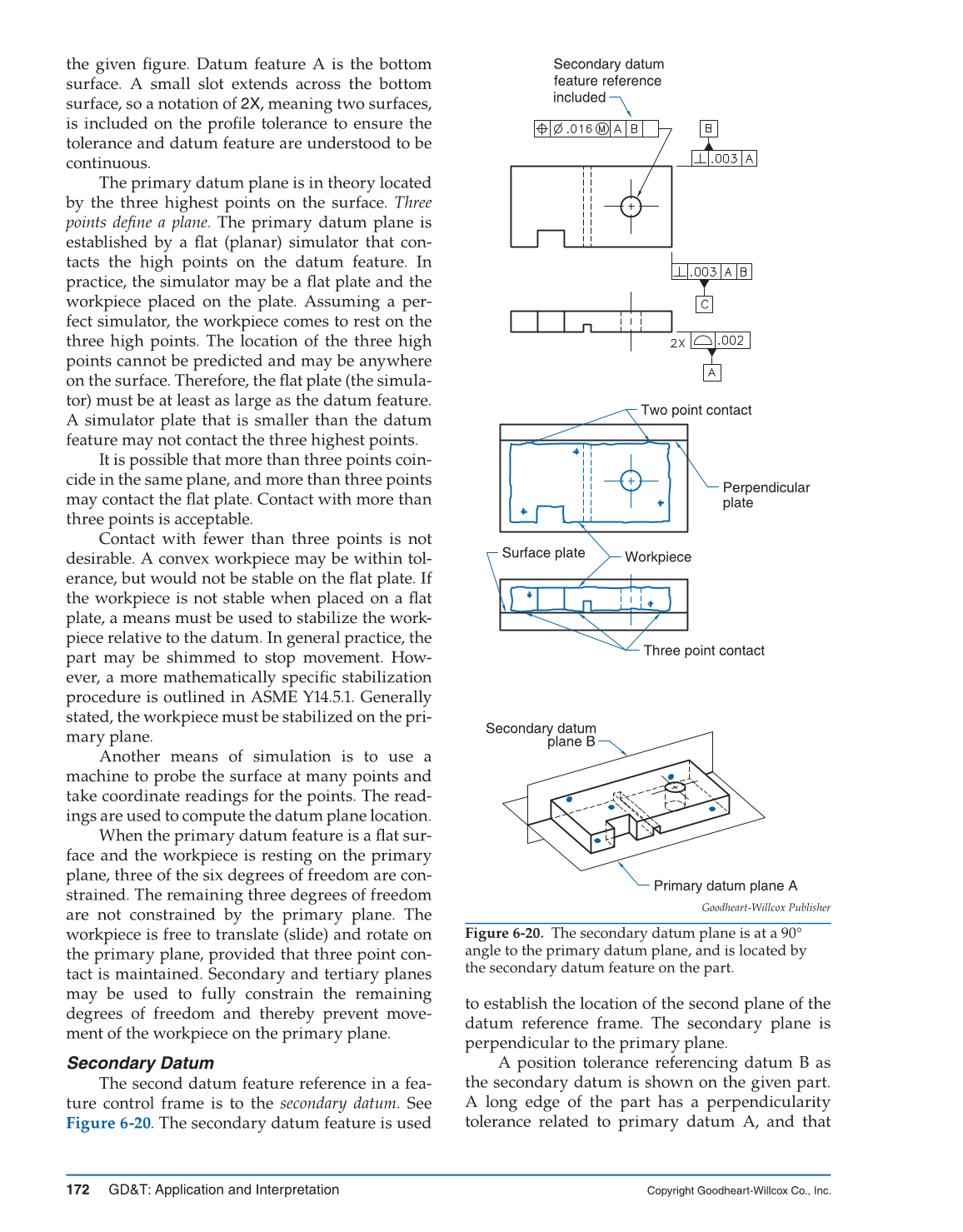172 GD&T: Application and Interpretation
Copyright Goodheart-Willcox Co., Inc.
the given fi gure. Datum feature A is the bottom
surface. A small slot extends across the bottom
surface, so a notation of 2X, meaning two surfaces,
is included on the profi le tolerance to ensure the
tolerance and datum feature are understood to be
continuous.
The primary datum plane is in theory located
by the three highest points on the surface. Three
points defi ne a plane. The primary datum plane is
established by a fl at (planar) simulator that con-
tacts the high points on the datum feature. In
practice, the simulator may be a fl at plate and the
workpiece placed on the plate. Assuming a per-
fect simulator, the workpiece comes to rest on the
three high points. The location of the three high
points cannot be predicted and may be anywhere
on the surface. Therefore, the fl at plate (the simula-
tor) must be at least as large as the datum feature.
A simulator plate that is smaller than the datum
feature may not contact the three highest points.
It is possible that more than three points coin-
cide in the same plane, and more than three points
may contact the fl at plate. Contact with more than
three points is acceptable.
Contact with fewer than three points is not
desirable. A convex workpiece may be within tol-
erance, but would not be stable on the fl at plate. If
the workpiece is not stable when placed on a fl at
plate, a means must be used to stabilize the work-
piece relative to the datum. In general practice, the
part may be shimmed to stop movement. How-
ever, a more mathematically specifi c stabilization
procedure is outlined in ASME Y14.5.1. Generally
stated, the workpiece must be stabilized on the pri-
mary plane.
Another means of simulation is to use a
machine to probe the surface at many points and
take coordinate readings for the points. The read-
ings are used to compute the datum plane location.
When the primary datum feature is a fl at sur-
face and the workpiece is resting on the primary
plane, three of the six degrees of freedom are con-
strained. The remaining three degrees of freedom
are not constrained by the primary plane. The
workpiece is free to translate (slide) and rotate on
the primary plane, provided that three point con-
tact is maintained. Secondary and tertiary planes
may be used to fully constrain the remaining
degrees of freedom and thereby prevent move-
ment of the workpiece on the primary plane.
Secondary Datum
The second datum feature reference in a fea-
ture control frame is to the secondary datum. See
Figure 6-20. The secondary datum feature is used
to establish the location of the second plane of the
datum reference frame. The secondary plane is
perpendicular to the primary plane.
A position tolerance referencing datum B as
the secondary datum is shown on the given part.
A long edge of the part has a perpendicularity
tolerance related to primary datum A, and that
Primary datum plane A
Secondary datum
plane B
Two point contact
Three point contact
Perpendicular
plate
Workpiece
Surface plate
Secondary datum
feature reference
included
Goodheart-Willcox Publisher
Figure 6-20. The secondary datum plane is at a 90°
angle to the primary datum plane, and is located by
the secondary datum feature on the part.
